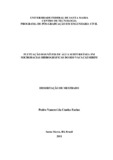| dc.creator | Farias, Pedro Vanerci da Cunha | |
| dc.date.accessioned | 2012-09-04 | |
| dc.date.available | 2012-09-04 | |
| dc.date.issued | 2011-09-09 | |
| dc.identifier.citation | FARIAS, Pedro Vanerci da Cunha. Groundwater levels fluctuation in Vacacaí-Mirim river small watersheds. 2011. 102 f. Dissertação (Mestrado em Engenharia Civil) - Universidade Federal de Santa Maria, Santa Maria, 2011. | por |
| dc.identifier.uri | http://repositorio.ufsm.br/handle/1/7777 | |
| dc.description.abstract | The intention in this work is to study (locally) the fluctuation system of groundwater levels in two small watersheds. We selected Rancho do Amaral and Rincão do Soturno small watersheds for being representative of the first order streams which compose the Vacacaí-Mirim river watershed headwaters. Both are located at the border of Paraná Sedimentary Basin, in the central region of the state of Rio Grande do Sul. These small watersheds belong to the municipalities of Itaara and Santa Maria, and they are contributors of the Brazilian hydrographic region South Atlantic. They are considered exceptionally important for the municipality of Santa Maria because they are the main drinking water sources for the DNOS Dam at the Vacacaí-Mirim river. They belong to the system in which water is accumulated and provided to the population. The area under study is part of overlying sandstone in the Botucatu Formation, which belongs to the Guarani Aquifer System. In order to carry out the studies, three monitoring wells were made with equipment measuring the water levels and atmospheric pressure. The equipment was set to automatically take readings every hour. Based on the date collected from the equipment, we mounted a database and applied it to a specific computer program, which allowed us to adopt the Water Table Fluctuation (WTF) method. This method only applies to unconfined aquifers and measures direct groundwater recharges in drainage basins. The recharge was estimated to be 833.0 mm at well number 5; 746.2 mm at well number 6 and 467.2 mm at well number 7 during the period of evaluation. Therefore, the presence of groundwater recharge confirmed our work hypothesis. | eng |
| dc.description.sponsorship | Coordenação de Aperfeiçoamento de Pessoal de Nível Superior | |
| dc.format | application/pdf | por |
| dc.language | por | por |
| dc.publisher | Universidade Federal de Santa Maria | por |
| dc.rights | Acesso Aberto | por |
| dc.subject | Água subterrânea | por |
| dc.subject | Water table fluctuation | por |
| dc.subject | Monitoramento | por |
| dc.subject | Recarga de aquífero | por |
| dc.subject | Groundwater | eng |
| dc.subject | Water Table Fluctuation | eng |
| dc.subject | Monitoring | eng |
| dc.subject | Aquifer recharge | eng |
| dc.title | Flutuação dos níveis de água subterrânea em microbacias hidrográficas do rio Vacacaí-Mirim | por |
| dc.title.alternative | Groundwater levels fluctuation in Vacacaí-Mirim river small watersheds | eng |
| dc.type | Dissertação | por |
| dc.description.resumo | A intenção neste trabalho foi de estudar, na situação local, o sistema de flutuação dos níveis de água subterrânea em duas microbacias hidrográficas. Foram selecionadas as microbacias Rancho do Amaral e Rincão do Soturno , por serem representativas de curso de água de primeira ordem, fazendo parte das cabeceiras da bacia hidrográfica do Rio Vacacaí-Mirim. Ambas situadas na borda da Bacia Sedimentar do Paraná, compreendendo a região central do Estado do Rio Grande do Sul. Estas microbacias pertencem aos municípios de Itaara e Santa Maria, e são contribuintes da região hidrográfica brasileira Atlântico Sul. Consideram-se excepcionalmente importantes para o município de Santa Maria/RS, pois são as principais fornecedoras de água potável para a barragem do DNOS, no Rio Vacacaí-Mirim, pertencente ao sistema de acumulação e distribuição de água à população. A área em estudo faz parte de afloramentos de arenitos da Formação Botucatu pertencentes ao Sistema Aquífero Guarani. Para a execução do estudo foram perfurados 3 (três) poços de monitoramento e neles instalados equipamentos de medição de nível de água e de pressão atmosférica, que são automáticos e configurados para realizarem leituras de hora em hora. Com base nos dados obtidos pelos equipamentos montou-se um banco de informações, que, aplicadas a um programa de computador específico, permitiram a adoção do método WTF (Water Table Fluctuation). Este método somente se aplica a aquífero livre e determina a recarga direta dos mananciais de água subterrânea. Estimou-se a recarga em 833 mm no Poço 5; 746,2 mm no Poço 6 e 467,2 mm no Poço 7, durante o período avaliado. A hipótese de trabalho foi comprovada, indicando haver recarga de água subterrânea. | por |
| dc.contributor.advisor1 | Silva, Jose Luiz Silverio da | |
| dc.contributor.advisor1Lattes | http://lattes.cnpq.br/9689434318472831 | por |
| dc.contributor.referee1 | Wendland, Edson Cezar | |
| dc.contributor.referee1Lattes | http://lattes.cnpq.br/3893936996168895 | por |
| dc.contributor.referee2 | Pinheiro, Rinaldo Jose Barbosa | |
| dc.contributor.referee2Lattes | http://lattes.cnpq.br/1539316781096410 | por |
| dc.creator.Lattes | http://lattes.cnpq.br/7538334547980349 | por |
| dc.publisher.country | BR | por |
| dc.publisher.department | Engenharia Civil | por |
| dc.publisher.initials | UFSM | por |
| dc.publisher.program | Programa de Pós-Graduação em Engenharia Civil | por |
| dc.subject.cnpq | CNPQ::ENGENHARIAS::ENGENHARIA CIVIL | por |


